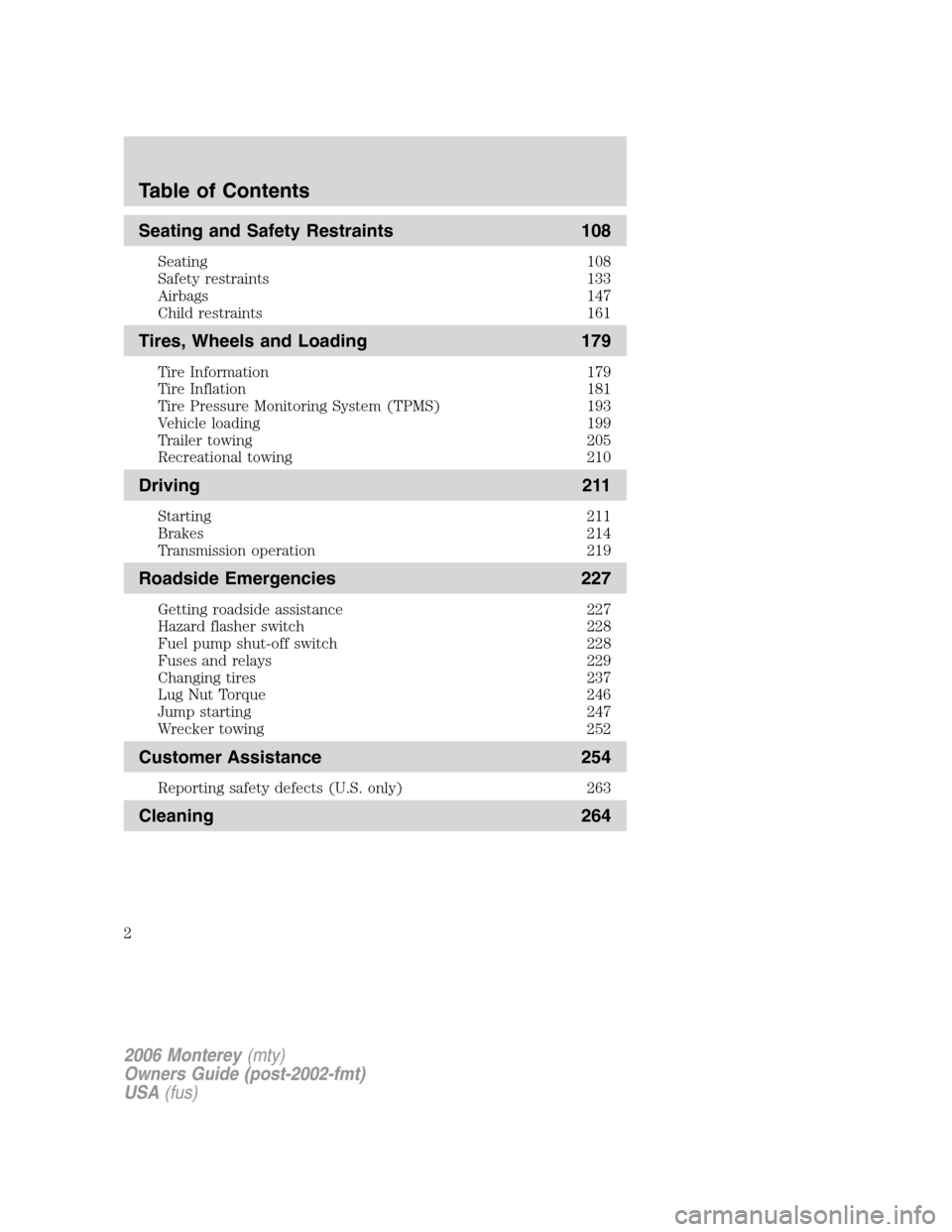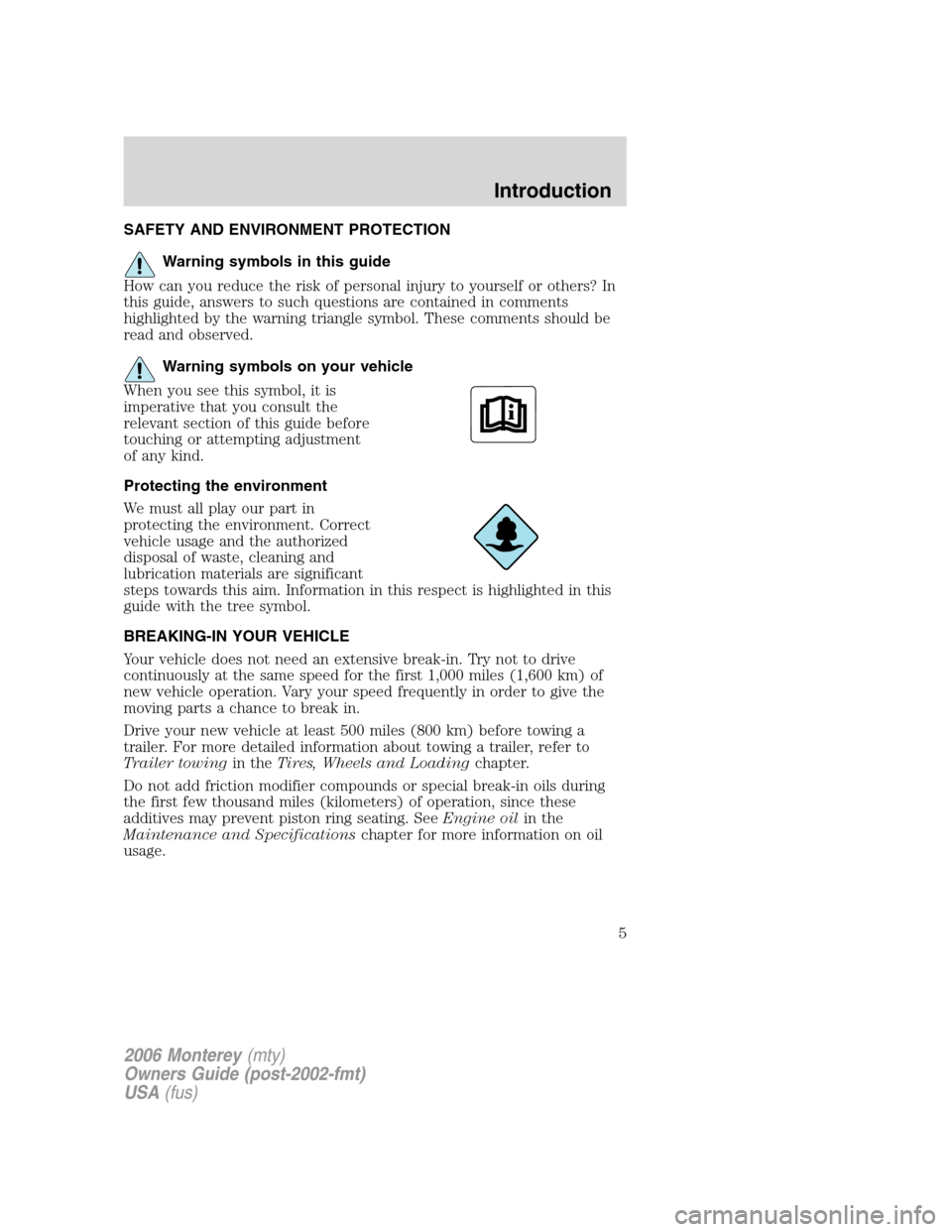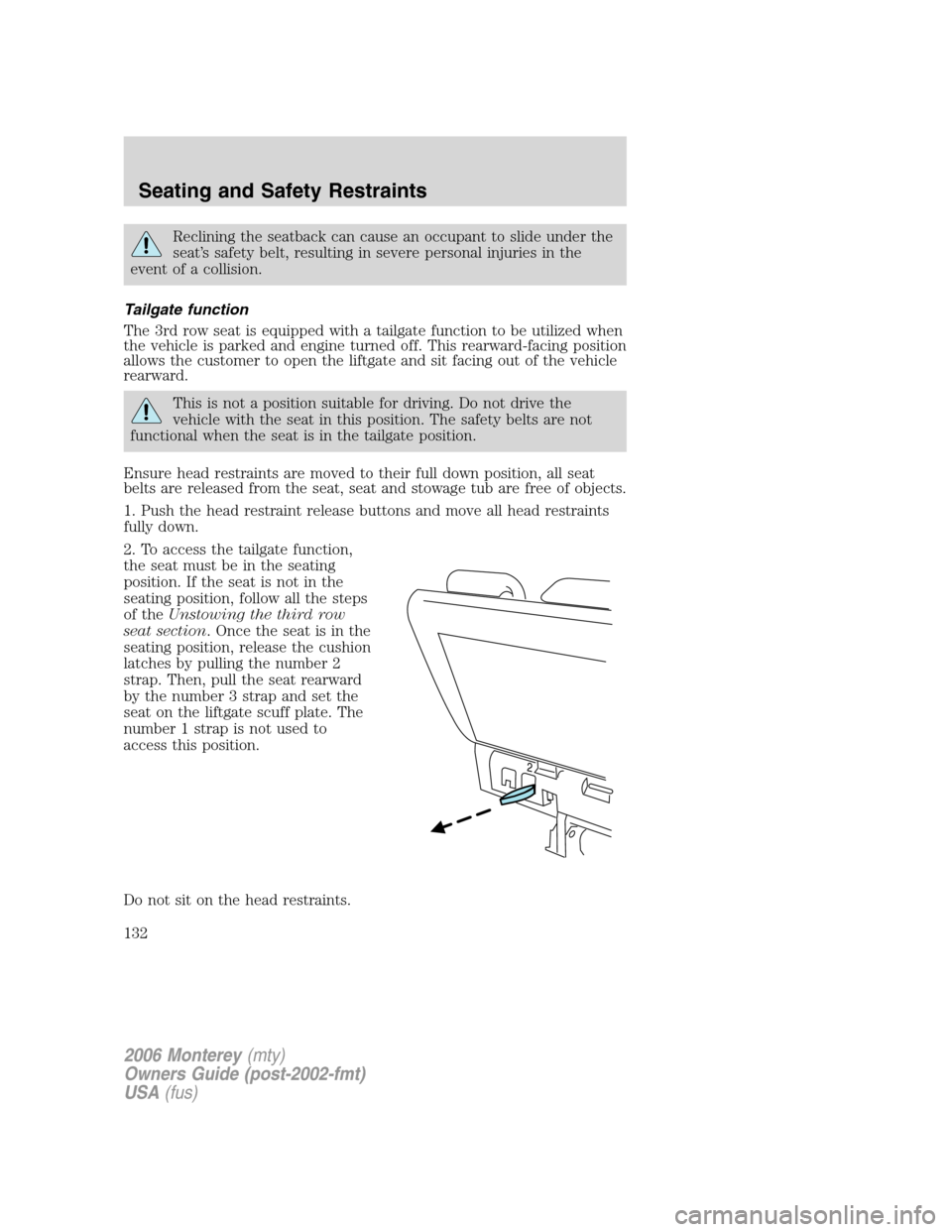towing Mercury Monterey 2006 Owner's Manuals
[x] Cancel search | Manufacturer: MERCURY, Model Year: 2006, Model line: Monterey, Model: Mercury Monterey 2006Pages: 320, PDF Size: 3.57 MB
Page 2 of 320

Seating and Safety Restraints 108
Seating 108
Safety restraints 133
Airbags 147
Child restraints 161
Tires, Wheels and Loading 179
Tire Information 179
Tire Inflation 181
Tire Pressure Monitoring System (TPMS) 193
Vehicle loading 199
Trailer towing 205
Recreational towing 210
Driving 211
Starting 211
Brakes 214
Transmission operation 219
Roadside Emergencies 227
Getting roadside assistance 227
Hazard flasher switch 228
Fuel pump shut-off switch 228
Fuses and relays 229
Changing tires 237
Lug Nut Torque 246
Jump starting 247
Wrecker towing 252
Customer Assistance 254
Reporting safety defects (U.S. only) 263
Cleaning 264
Table of Contents
2
2006 Monterey(mty)
Owners Guide (post-2002-fmt)
USA(fus)
Page 5 of 320

SAFETY AND ENVIRONMENT PROTECTION
Warning symbols in this guide
How can you reduce the risk of personal injury to yourself or others? In
this guide, answers to such questions are contained in comments
highlighted by the warning triangle symbol. These comments should be
read and observed.
Warning symbols on your vehicle
When you see this symbol, it is
imperative that you consult the
relevant section of this guide before
touching or attempting adjustment
of any kind.
Protecting the environment
We must all play our part in
protecting the environment. Correct
vehicle usage and the authorized
disposal of waste, cleaning and
lubrication materials are significant
steps towards this aim. Information in this respect is highlighted in this
guide with the tree symbol.
BREAKING-IN YOUR VEHICLE
Your vehicle does not need an extensive break-in. Try not to drive
continuously at the same speed for the first 1,000 miles (1,600 km) of
new vehicle operation. Vary your speed frequently in order to give the
moving parts a chance to break in.
Drive your new vehicle at least 500 miles (800 km) before towing a
trailer. For more detailed information about towing a trailer, refer to
Trailer towingin theTires, Wheels and Loadingchapter.
Do not add friction modifier compounds or special break-in oils during
the first few thousand miles (kilometers) of operation, since these
additives may prevent piston ring seating. SeeEngine oilin the
Maintenance and Specificationschapter for more information on oil
usage.
2006 Monterey(mty)
Owners Guide (post-2002-fmt)
USA(fus)
Introduction
5
Page 126 of 320

3. Lower back of seat onto the rear
tubs until both release controls latch
into place. Be sure that the seat is
locked in place both front and back.
Do not place the seat front hooks on the front most pin of the front tub.
Doing so will not allow the seat to fully install in vehicle.
Ensure seat is latched to vehicle floor by pushing/pulling on seat.
If not latched, the seat may cause injury during a sudden stop.
Stowing the third row seat
1. If the comfort guide is on the
center lap/shoulder belt, slip the
guide off the belt and stow the
guide in the pocket on the back of
the seat.
2006 Monterey(mty)
Owners Guide (post-2002-fmt)
USA(fus)
Seating and Safety Restraints
126
Page 130 of 320

8. Pull the number 3 strap on the seat back to tumble seat all the way in
to the tub in the floor.
Do not use the seat anchors as cargo tie downs.
Unstowing the third row seat
Ensure seat latching area is free of objects.
1. Lift the seat out of the tub in the
floor by pulling up on the exposed
strap or handle. Once seat is at a
vertical position, push the seat over,
letting it fall onto the latches.
2006 Monterey(mty)
Owners Guide (post-2002-fmt)
USA(fus)
Seating and Safety Restraints
130
Page 132 of 320

Reclining the seatback can cause an occupant to slide under the
seat’s safety belt, resulting in severe personal injuries in the
event of a collision.
Tailgate function
The 3rd row seat is equipped with a tailgate function to be utilized when
the vehicle is parked and engine turned off. This rearward-facing position
allows the customer to open the liftgate and sit facing out of the vehicle
rearward.
This is not a position suitable for driving. Do not drive the
vehicle with the seat in this position. The safety belts are not
functional when the seat is in the tailgate position.
Ensure head restraints are moved to their full down position, all seat
belts are released from the seat, seat and stowage tub are free of objects.
1. Push the head restraint release buttons and move all head restraints
fully down.
2. To access the tailgate function,
the seat must be in the seating
position. If the seat is not in the
seating position, follow all the steps
of theUnstowing the third row
seat section. Once the seat is in the
seating position, release the cushion
latches by pulling the number 2
strap. Then, pull the seat rearward
by the number 3 strap and set the
seat on the liftgate scuff plate. The
number 1 strap is not used to
access this position.
Do not sit on the head restraints.
2
2006 Monterey(mty)
Owners Guide (post-2002-fmt)
USA(fus)
Seating and Safety Restraints
132
Page 141 of 320

Position the safety belt height adjusters so that the belt rests
across the middle of your shoulder. Failure to adjust the safety
belt properly could reduce the effectiveness of the safety belt and
increase the risk of injury in a collision.
Third row comfort guide
Note:Before stowing the third row seat or folding the third row seat
back down, the center seat lap/shoulder belt needs to either have the
cross lap tongue stowed in the pocket on the belt or the entire belt
needs to be stowed in the roof.
The safety belt for the 3rd row
center occupant may be stowed in
the ceiling if it has been detached
from the seat to carry large cargo.
Remove the safety belt from the
stowage area on the ceiling and
buckle the small tongue on the end
of the safety belt to the mini-buckle
on the left side of the center seat
position.
The third row center lap/shoulder
belt is equipped with a Belt Comfort
Guide located in a pocket on the
back of the seat. The guide is
attached to the driver’s side head
restraint, and is used to adjust the
comfort of the shoulder belt for
smaller occupants in the center
position of the 3rd row seat. To
adjust the comfort guide:
•Slip the shoulder belt into the
belt guide.
•Slide the guide up or down along the head restraint post so that the
belt is centered on the occupant’s shoulder.
Safety belt warning light and indicator chime
The safety belt warning light illuminates in the instrument cluster and a
chime sounds to remind the occupants to fasten their safety belts.
2006 Monterey(mty)
Owners Guide (post-2002-fmt)
USA(fus)
Seating and Safety Restraints
141
Page 201 of 320

Example only:
Cargo Weight– includes all weight added to the Base Curb Weight,
including cargo and optional equipment. When towing, trailer tongue load
or king pin weight is also part of cargo weight.
2006 Monterey(mty)
Owners Guide (post-2002-fmt)
USA(fus)
Tires, Wheels and Loading
201
Page 202 of 320

GAW (Gross Axle Weight)– is the total weight placed on each axle
(front and rear) – including vehicle curb weight and all payload.
GAWR (Gross Axle Weight Rating)– is the maximum allowable
weight that can be carried by a single axle (front or rear).These
numbers are shown on the Safety Compliance Certification Label
located on the B-Pillar or the edge of the driver’s door. The total
load on each axle must never exceed its GAWR.
Exceeding the Safety Compliance Certification Label axle weight
rating limits could result in substandard vehicle handling or
performance, engine, transmission and/or structural damage, serious
damage to the vehicle, loss of control and personal injury.
Note:For trailer towing information refer toTrailer towingfound in
this chapter or theRV and Trailer Towing Guideprovided by your
authorized dealer.
GVW (Gross Vehicle Weight)– is the Vehicle Curb Weight + cargo +
passengers.
2006 Monterey(mty)
Owners Guide (post-2002-fmt)
USA(fus)
Tires, Wheels and Loading
202
Page 203 of 320

GVWR (Gross Vehicle Weight
Rating)– is the maximum
allowable weight of the fully loaded
vehicle (including all options,
equipment, passengers and cargo).
The GVWR is shown on the
Safety Compliance Certification
Label located on the B-Pillar or
the edge of the driver’s door.
The GVW must never exceed the
GVWR.
Exceeding the Safety Compliance Certification Label vehicle
weight rating limits could result in substandard vehicle handling
or performance, engine, transmission and/or structural damage, serious
damage to the vehicle, loss of control and personal injury.
GCW (Gross Combined Weight)– is the weight of the loaded vehicle
(GVW) plus the weight of the fully loaded trailer.
GCWR (Gross Combined Weight Rating)– is the maximum allowable
weight of the vehicle and the loaded trailer – including all cargo and
passengers – that the vehicle can handle without risking damage.
(Important: The towing vehicles’ braking system is rated for operation at
GVWR, not at GCWR. Separate functional brakes should be used for safe
control of towed vehicles and for trailers where the GCW of the towing
vehicle plus the trailer exceed the GVWR of the towing vehicle.The
GCW must never exceed the GCWR.
Maximum Loaded Trailer Weight– is the highest possible weight of a
fully loaded trailer the vehicle can tow. It assumes a vehicle with only
2006 Monterey(mty)
Owners Guide (post-2002-fmt)
USA(fus)
Tires, Wheels and Loading
203
Page 204 of 320
![Mercury Monterey 2006 Owners Manuals mandatory options, no cargo (internal or external), a tongue load of
10–15% (conventional trailer) or king pin weight of 15–25% (fifth wheel
trailer), and driver only (150 lb. [68 kg]).Consult you Mercury Monterey 2006 Owners Manuals mandatory options, no cargo (internal or external), a tongue load of
10–15% (conventional trailer) or king pin weight of 15–25% (fifth wheel
trailer), and driver only (150 lb. [68 kg]).Consult you](/img/33/10965/w960_10965-203.png)
mandatory options, no cargo (internal or external), a tongue load of
10–15% (conventional trailer) or king pin weight of 15–25% (fifth wheel
trailer), and driver only (150 lb. [68 kg]).Consult your authorized
dealer (or theRV and Trailer Towing Guideprovided by your
authorized dealer) for more detailed information.
Do not exceed the GVWR or the GAWR specified on the Safety
Compliance Certification Label.
Do not use replacement tires with lower load carrying capacities
than the originals because they may lower the vehicle’s GVWR
and GAWR limitations. Replacement tires with a higher limit than the
originals do not increase the GVWR and GAWR limitations.
Exceeding any vehicle weight rating limitation could result in
serious damage to the vehicle and/or personal injury.
Steps for determining the correct load limit:
1. Locate the statement “The combined weight of occupants and cargo
should never exceed XXX kg or XXX lbs.” on your vehicle’s placard.
2. Determine the combined weight of the driver and passengers that will
be riding in your vehicle.
3. Subtract the combined weight of the driver and passengers from XXX
kg or XXX lbs.
4. The resulting figure equals the available amount of cargo and luggage
load capacity. For example, if the “XXX” amount equals 1,400 lbs. and
there will be five 150 lb. passengers in your vehicle, the amount of
available cargo and luggage load capacity is 650 lbs. (1400–750 (5 x 150)
= 650 lb.). In metric units (635–340 (5 x 68) = 295 kg.)
5. Determine the combined weight of luggage and cargo being loaded on
the vehicle. That weight may not safely exceed the available cargo and
luggage load capacity calculated in Step 4.
6. If your vehicle will be towing a trailer, load from your trailer will be
transferred to your vehicle. Consult this manual to determine how this
reduces the available cargo and luggage load capacity of your vehicle.
The following gives you a few examples on how to calculate the available
amount of cargo and luggage load capacity:
•Another example for your vehicle with 1400 lb. (635 kg) of cargo and
luggage capacity. You decide to go golfing. Is there enough load
2006 Monterey(mty)
Owners Guide (post-2002-fmt)
USA(fus)
Tires, Wheels and Loading
204